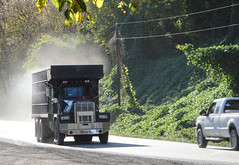More illness in mining areas, new research finds

A new study has affirmed what most people in Floyd County already know: living in an area where there is coal mining is bad for one's health.
The study published last week in the Journal of Rural Health found that Floyd County residents were more likely to report higher incidences of asthma, chronic obstructive pulmonary disease, illnesses involving multiple organs, and general illness than residents in non-mining communities. Residents also reported more serious illness and cancer deaths in family members.
“Any one who has lived near a strip mine site, or just driven along one of the major coal haul roads like Highway 23, knows dust is a persistent problem, and we know this same dust causes silicosis in mine workers, both surface and underground,” said Floyd County resident and KFTC member Bev May, a nurse practitioner in eastern Kentucky for 18 years. “The excess chronic lung disease this study found in Floyd County supports my own observations that dust from surface mining is not just an annoyance, but a risk to our health.”
Resources
The Journal of Rural Health article, Personal and Family Health in Rural Areas of Kentucky With and Without Mountaintop Coal Mining, can be found here.
Other studies
Nearly two dozen other studies have documented higher rates of a variety of illnesses including cancer, more birth defects and a lower life expectancy. Find a summary of those studies here.
A 2011 study from the University of Kentucky found a higher incidence of lung cancer and exposure to trace elements in most eastern Kentucky counties. Download a PowerPoint with the results here.
Another 2011 UK study found lung cancer rates in Appalachian Kentucky almost twice national rates, and that Appalachian residents were exposed to higher concentrations of arsenic, chromium and nickel than Jefferson County, Kentucky residents.
The health study data was acquired through a community participatory health survey of residents in Floyd County, where mountaintop mining is taking place, and compared to results from a similar study in nearby Elliott and Rowan counties where coal mining is not taking place. More than 950 residents were interviewed last year for the study.
"We found that the people who lived in the mining area had significantly elevated risk for a variety of health problems, including respiratory," said the report's author Michael Hendryx, chair of the Department of Health Policy, Management and Leadership in the School of Public Health and director, West Virginia Rural Health Research Center of West Virginia University. He has been involved in research in other areas of the Appalachian region that found similar health disparities between communities where coal is mined and where it is not.
"We are seeing these effects that extend to a wide variety of illness and … find higher reports of illness in ways that are not explained," Dr. Hendryx said at Monday morning press conference. "We don’t understand exactly what the causes are, but there is a lot of evidence [of] an environmental contribution. Based on everything that I’ve seen, I believe there is. I think mountaintop removal mining should stop and we should find other ways to grow the economy in these areas."
In the press conference, May pointed to two other studies done at the University of Kentucky that confirm the greater incidence of lung disease in Floyd and surrounding counties, and exposure to higher levels to trace minerals such as arsenic, chromium and nickel in toenails compared to non-mining areas.
"There are a number of studies that keep pointing us in the same direction," May said.
The UK lung cancer study identified three clusters of counties with elevated levels of lung cancer. "Cluster number 1 was centered right over Floyd County with a 21% higher risk" than other areas of the state, May pointed out. When this map was overlaid with a map of coal production, the maps were nearly identical.
Greater awareness of the air pollution and health problems resulting from strip mining is growing and becoming as serious of a threat as the poisoning of the water and destruction of the land. The use of high explosives and heavy machinery, the processing and loading coal, and hauling it on unpaved roads all generate fine dust and soot and release heavy metals into the air and waterways.
"There is beginning to be more and more evidence that there is air pollution … coming from the overburden and the coal itself," Hendryx explained. In other studies researchers are finding "much higher counts of ultrafine participles … that can penetrate into the lungs and even into the bloodstream. Most of what it is is silica and some organic compounds … that we know from other research that can contribute to respiratory and heart disease."
May said she sees this everyday in her job as a nurse practioner: "You can’t practice in eastern Kentucky without knowing there is a lot of asthma and a lot of lung cancer. It all points back to something in the environment beyond the known risk factors.
"It saddens me that this work wasn’t done 10 or 20 years ago," May added. "There is enough research right now to say that more mining is only going to create more health problems. We need to take action now."
Deborah Payne with the Kentucky Environmental Foundation had some specific demands on how public officials can take ation.
"Public health is about prevention," she said referring to "the precautionary principle – it’s a very important concept when you’re working with environmental health. Our local and state officials have a duty to protect our people, and should not allow our environment to be drastically altered and then try to ignore the health consequences of those actions."
 May agreed. “I want my state Representative Greg Stumbo, and Representative Hal Rogers to know this: All the research points to what mountain people have known since mountaintop removal began: It is not possible to destroy our mountains without destroying ourselves. It’s not possible to poison our streams without poisoning our children for untold generations to come.”
May agreed. “I want my state Representative Greg Stumbo, and Representative Hal Rogers to know this: All the research points to what mountain people have known since mountaintop removal began: It is not possible to destroy our mountains without destroying ourselves. It’s not possible to poison our streams without poisoning our children for untold generations to come.”
One person not aware of – or not acknowledging – the increased health risks in Floyd County is the county's state representative, Greg Stumbo. He told Ronnie Ellis with the Community Newspaper Holdings: “I don’t believe that stuff for a minute. I’ve lived there all my life. There are no pollutants in the air. When you blow up something, it’s just dust for a little while and that’s the end of it. It’s not like the sky is blackened every day.”
He also said that residents of Rowan County are better educated because of the presence of Morehead State University there, and that skewed the results. Hendryx said results were screened for a long list of accepted research factors. "We did control for education level in the analysis."
Recent News
Kentucky’s past legislative session showed alarming trend toward government secrecy
Churchill Downs takes more than it gives. That's why the Kentucky Derby is a no-go for me
‘We must never forget.’ Kentucky town installs markers for lynching victims.
Featured Posts
Protecting the Earth
TJC Rolling Out The Vote Tour – a KFTC Reflection Essay
KFTC Voter Empowerment Contractor Reflection Essay
Archives
- Home
- |
- Sitemap
- |
- Get Involved
- |
- Privacy Policy
- |
- Press
- |
- About
- |
- Bill Tracker
- |
- Contact
- |
- Links
- |
- RSS




Add new comment